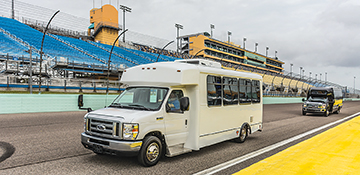
 Testing ensures safe accessibility
Testing ensures safe accessibility
By Robert Portney
There was a time when reinforcing a crack or failure simply meant throwing more steel at it. Today, however, advanced technology brings a much more analytical and scientific approach to assessing actual stress points.
REV Bus Group is one of a few OEMs that actually simulates the durability of a bus, as well as various crash events, to locate any stress and failure points that may need additional reinforcement. Physical testing follows in order to prove simulation findings.
With any new design, we start with a complete analysis of various failure modes. The next step is to develop a chart to predict failure modes in all circumstances, ranking them in the severity of the event; how difficult they are to detect; and when the failure might occur. Then, we design to each of those failure modes and more importantly, test to help ensure they never happen.

Passenger safety is the first consideration in testing the structure, and that certainly includes safe accessibility for wheelchair passengers. The Americans with Disabilities Act (ADA) requires specific testing for a wheelchair-accessible bus. Additionally, REV Bus Group has developed its own simulation for every pull test needed for the tie-downs and attachment points.
Once the overall durability testing is complete, attention is solely focused on the wheelchair areas. However, it first requires scientifically testing the underlying structure and proving it is sound; followed by quality checks at the weld points as the bus is being manufactured.
Of course, a low-floor bus alleviates many ADA concerns that involve wheelchair lifts. The standard wheelchair ramp in a low-floor bus is far less complicated, simpler to operate and typically requires less maintenance. A ramp always works. If the electronic or hydraulic system is not functioning, the ramp can always be deployed manually very easily.
According to ADA guidelines, wheelchair access requires specific wheelchair footprints and maneuverability requirements in terms of turning radius. So OEMs look to the ADA and federal requirements, but also refer to the APTA guidelines to ensure wheelchair positions are compliant. Wheelchairs secure to restraints attached to the floor and a seatbelt attaches to the sidewall. REV Bus Group thoroughly tests these areas for structural soundness, as well.
Starting with the wheelchair ramp itself, OEMs cycle test the ramp to support 1,000 pounds in a simulation of a 7- to 10-year life cycle of the bus. The 1,000 pounds represents the weight of an individual and the typical mobility scooter. Side-impact and roof-crush testing is important as well, along with roll-over simulations. While these are not federal requirements, REV Bus Group takes safety very seriously and goes beyond the required testing for a typical transit bus.
REV Bus Group recently partnered with the University of Buffalo in a comprehensive accessibility study that involved more than 20 mobility-challenged individuals. Their assignment was to ride a bus and rate it for both for ease and comfort in maneuvering on and off the bus. REV Bus Group incorporated many of the observations gleaned from the study into their bus design.
The safest accessibility is dependent on FTA testing and analysis – and then subjecting those findings to the biggest test of all: feedback from the people who ride — and depend on — demand-response vehicles.
Robert Portney is the engineering director for Champion Bus and Goshen Coach, part of the REV Bus Group. Portney has many years of valuable industry experience in bus and truck engineering and safety. Visit www.revgroup.com.
